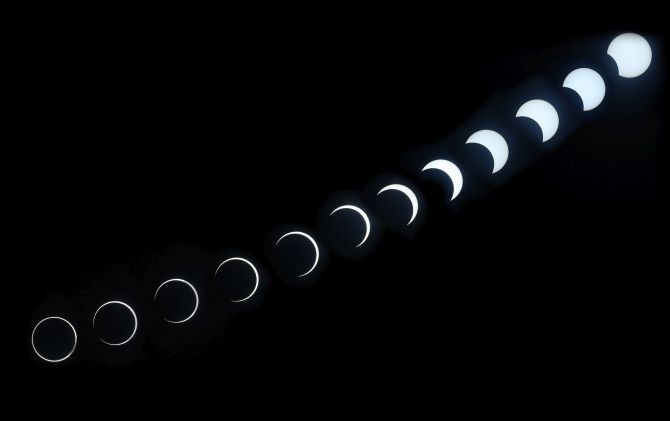The Moon on Thursday slowly masked the Sun to leave just a burning ring of fire in what was the last solar eclipse of the decade, an astronomical phenomenon witnessed by thousands of scientists and spiritualists across India.

As the Moon came in between the Earth and the Sun and the three celestial bodies aligned, people gathered on rooftops, beaches and other open spaces as well as planetariums to watch the flaming solar disc.
But overcast skies and fog played spoilsport in many parts, particularly north India, leaving those in towns such as Kozhikode in Kerala to watch the eclipse unfold in clear skies.
The partial phase of the eclipse began at 8 am and the annular phase at 9.06 am. The annular phase ended 12.29 pm, while the partial phase ended at 13.36 pm, the Ministry of Earth Sciences said.
An annular solar eclipse occurs when the angular diameter of the Moon falls short of the Sun so it cannot cover the latter completely. As a result, the Sun is visible only as a 'ring of fire' around the Moon.

The obscuration of the Sun by the Moon at the time of greatest phase of partial eclipse would be around 90 per cent in Bengaluru, 85 per cent in Chennai, 79 per cent in Mumbai, 45 per cent in Kolkata, 45 per cent in Delhi, 42 per cent in Patna, 33 percent in Guwahati, 70 per cent in Port Blair, 35 per cent in Silchar, the MoES said in a statement last week.
The rigours of space science and the arcane world of religion and myths merged as they do with every eclipse.

Various temples, including the famous Lord Ayyappa Temple in Sabarimala, the Padmanabha Swamy temple at Thiruvananthapuram and the Lord Krishna temple at Guruvayur were closed during the solar eclipse, believed to be inauspicious by some.
In Bhopal's Moti Masjid, Muslim devotees offered the Namaz-e-Kusuf, a special prayer, during the solar eclipse.

While thousands braved the cold to take a dip in rivers in different parts of the country in accordance with ancient rituals, students, scientists and space enthusiasts queued up outside telescopes set up in planetariums and other open spaces to watch the celestial phenomenon unfold.
Prime Minister Narendra Modi was among the enthusiasts who wanted to view the annular phenomenon but the fog blocked his view.

"Like many Indians, I was enthusiastic about #solareclipse2019. Unfortunately, I could not see the Sun due to cloud cover but I did catch glimpses of the eclipse in Kozhikode and other parts on live stream. Also enriched my knowledge on the subject by interacting with experts," he said on Twitter.
The prime minister said he enriched his knowledge on the subject by interacting with experts.
When a Twitter user posted a picture of Modi looking up at the Sun and said it was becoming a meme, Modi took the remark in his stride and responded with, "Most welcome....enjoy :)".

The MoES advised people to not watch the eclipse with the naked eye.
According to Arvind Paranjpye, director of the Nehru Planetarium in Mumbai, more than 600 people watched the eclipse through a projection box set up in the premises.
Paranjype, however, was part of the Mumbai-based astronomy group that witnessed the eclipse from an aircraft.

Jyotirvidya Pratishthan, a Pune based association of amateur astronomers, said the organisation had set up telescopes on the Z-Bridge of the city but the view of the eclipse was hindered by cloudy skies.
Though there are many myths associated with eclipses, Paranjype said there has been a change in attitude over the years.

"Now people are more forthcoming and want to witness the event," he said.
The annular eclipse of the Sun was visible within a narrow corridor in the Northern Hemisphere near the equator. Its path passed through Saudi Arabia, Qatar, Oman, UAE, India, northern Sri Lanka, Malaysia, Singapore, Sumatra and Borneo.

The next solar eclipse will be visible from India on June 21 2020.
It will also be an annular solar eclipse.
A narrow path of annularity will pass through northern part of India. From the rest part of the country it will be seen as partial solar eclipse, the MoES said.










